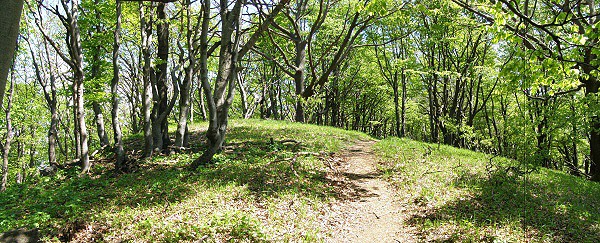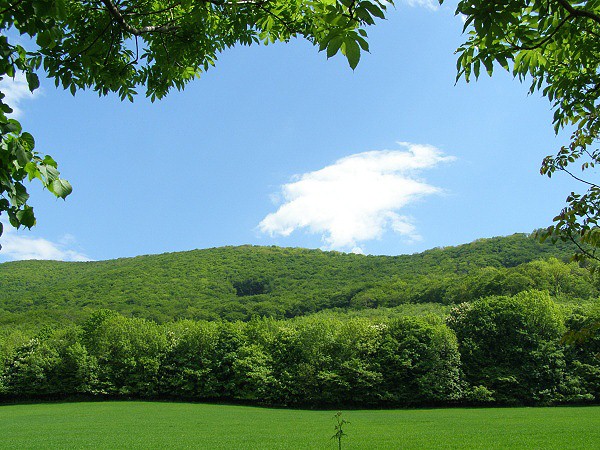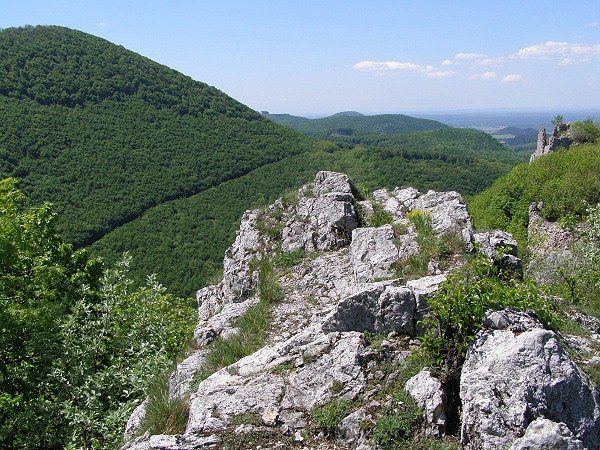Welcome Smoleniciach
Under the picturesque foothills of the Little Carpathians juhovýchodným extends around the village Smolenice. It has a population of approximately 3200 and belongs to the district of Trnava. Smolenice are documented for the first time in a document of 1256 as Solmus villa. Smolenice name is probably derived from a smoliarov, producers pitch. In 13. century belonged to the complex Pezinský-svätojurských Grof, at the end 14. stor. Ctibor of Ctiboríc, then again Pezinská-svätojurským grófom in 16. stor. Országovcom and from 17. stor. have become a vassal municipality Smolenice castle, which belonged Pálffyovcom. At the turn 15. and 16. stor. Smolenice have become a small town, have been fenced so stavaným Muro Sentinel tower, bastions. Mali its crest, the pillar of shame (pillory), Catchpole and Deres. From 18. century is the weekly markets were held, shop and Cattle Fairs.
Smolenice name is probably derived from a smoliarov, producers pitch. In 13. century belonged to the complex Pezinský-svätojurských Grof, at the end 14. stor. Ctibor of Ctiboríc, then again Pezinská-svätojurským grófom in 16. stor. Országovcom and from 17. stor. have become a vassal municipality Smolenice castle, which belonged Pálffyovcom. At the turn 15. and 16. stor. Smolenice have become a small town, have been fenced so stavaným Muro Sentinel tower, bastions. Mali its crest, the pillar of shame (pillory), Catchpole and Deres. From 18. century is the weekly markets were held, shop and Cattle Fairs.
Cave Driny
In the past, forestry ranger John Hirner, Teodor whose sons, Richard and Alexander were doing research in the beauty of Smolenickom, upozorornil smolenických enthusiasts at mysteriously Drinách a hole to where you were doing dens foxes, badger and marten. Sometimes there vliezol dog that chased the game and more back. Povrávalo is that the hole is deep and leads into the subterranean corridors, but niches is mine dared to run. In the year began 1920 canvas in Smolenickom beauties and particular Drinách separate group Smolenických enthusiasts whose sprvoti also enticed Janosikov treasures. Were it Imrich Vajsábel, Silvester Vallo, Alexander Vallo and Alojz Vajsábel. Later to join them Banič Stefan and his son John Banič. Everyone already knew the mysterious Drinách a hole and tried to apply it to clean. A crucial year became the year 1929 when you've decided to start with vyčisťovacími work in zatarasenom chimneys on Drinách. Will be the first to get to the bottom of the chimney: Imrich Vajsábel and John Banič whose deem objaviteľov Driny caves, at the end of 1929. Obidvaja then made the first blast of the chimney, thereby exposing them kvapľovou hallway with beautiful decorations. Be the first to schádzali visitors into the cave after objavným komínem rebríkoch at your own risk.

Smolenický Zamok
Placing Smolenického castle is on the north side of the village. Was built at the beginning of our century on the ruins of an old castle.
The old castle was built in the mid 15. century. Individual publishers him zväčšovali and adapted to your needs and tastes.

In 15. century rose Smolenice significance, because the village was built in the castle, which became the center and the seat of smolenickeho estate. Earlier 16. stor. Retrieving Smolenice Orszaghovci. In the year 1777 Analyze Jan Palffy in a deposit Smolenický gentry. Pálffyovci neobyvali Smolenický castle, which already for the last Erdo dyovca - Kristof III. declined, because it was not funding for maintenance. Artwork doom was consummated during the Napoleonic wars, ked zhorela main building of the castle and with piggybacking.

Nowaday Smolenický zamok began to build in the early 20. stor. smolenickeho owner and dobrovodskeho gentry Grof Juraj Palffy Wed , Before work on the wall chateau was started in the year 1887 regularizing bast. Bastion of the old castle remained, only the nadstavili and one umbrella. Grof Palffy had to stand in our own zamok handled internally by the architect Jozef Hubert. First World War was the cause of interruptions of civil works at the castle. Some of the rooms were only provisionally been adjusted and positioned them in the family archive Palffyovcov. Until the end of World War II on the construction site continued. The owners of the chateau 1945 became stat, zamok took over the SNR and chose him as his summer residence. Zamok was getting, equipment and 26.6.1953 SAV was uploaded to reprezentacnym became a meeting place for scientists from around the world.
Inside the chateau is located a few stylish modified salonov and corridors, but is not located there are no historically valuable equipment.

In the century 15th the Importance of Increased Smolenice considerable, because the castle was built and there Which Became the center and seat of the Smolenice estate. Early in the century 16th, Smolenice had been gained by the Orszagh family. In 1777, Jan Palffy Takes Smolenice estate as the pawn. The Palffy family did not live at the castle, Which snake Decayed considerable During the life of Kristof III, the last of the Erdödy family - they lacked money for maintenance. The decay was complete During the Napoleon Wars - the main castle building and the tower had burnt down.

Construction of the Smolenice Castle of today had been started early in the century by 20th Jozef Palffy Jr., the landlord of Smolenice Dobra Voda and estates. First work on the fortification walls 1887 already started in on the Bastions. Bastions from the old castle were preserved, with height extension and new roofing. The Count Palffy had built the castle at His own expense According to the design by architect Joseph Hubert. During World War 1, the construction was interrupted; provisional adaptation of some rooms was made and archives of the Palffy family was located there. The construction was not resumed before the end of World War 2. In 1945 the Castle Became the property of the State, it was Taken over by the Slovak National Council Who decided to have Their summer-house there. The castle was finished and furbished and handed over to the Slovak Academy of Sciences on June 26 1953 To Become a representative place for meetings of scientists from worldwide.
Museum Molpir
The museum is housed in an old rectory building. Form part of the exposure exhibits from Hallstatt Molpir fort. The museum has its own play area regional historian and teacher Stefan Jastrabík. One room belongs inventor fired Štefan Banic. Interesting is the exposure of old books 17. - 19. Century of farskej library. The corridors are well documented history of the village in the Figures. Flora and fauna Smolenice and the surrounding area together with minerals are in the next room. In the last room is ethnography Smolenice and surroundings.
opening hours: Tue-Sun 10: 00-16: 00 through the summer season
Room č.1, 2
ARCHAEOLOGICAL FINDINGS OF FORTIFIED had from an earlier period of the iron (7-6 spnl)
Room č.3
Štefan Banič room dedicated to the inventor fired
Room č.4
Farskej rare books from the library, playroom dedicated stefani Jastrabík and Alexandra Kotlán
Room č.5
Mesozoic and Cainozoic fossil from the surrounding Smolenice, fauna and flora of the Little Carpathians, a collection of butterflies
Room č.6
Reconstruction of the room of the late 19. Century authentic somersaults, tools, folk costumes
Gallery can Molpir

Water tanks Horne Orešany
The stream Parna was built northwest of the village, humiliate Igramského grove water tank Horne Orešany. In the past over a container constructed breeding ponds.

- Flow: Steam
- Volume: 3,50 mil.m3
- Flooded area: 0,50km2
- Purposes: ZRbEO (Z - A source of water for irrigation; Rb - fishing, E - the use of hydropower, O - protection against high waters)
| area: | 50 ha |
| Organization: | Mso Trnava |
| user: | SRZ |
| character: | carp water |
Zaruba - the highest peak of the Little Carpathians can smell garlic
Small Carpathians. Long slightly chiselled wooded fence stretching the length of almost one hundred kilometers separating from the Lower Záhorie Pováží. Beautiful scenic hills, which offer an abundance of beautiful views, fantastic rozhledových peaks, ruins of medieval castles, caves, bradel, valley ...
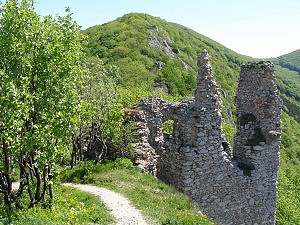
Small Carpathians lies somewhat outside the interest of tourists. Of these many "with flaps" on the eyes going to the Tatra Mountains to the endless here in droves went to meet a few points which are the tourist public. In the summer months.
In spring, autumn or winter, when Tatra MountainsIn addition to tourism concluded these "zaslepence" can not be bothered to visit the hills lying further to the southwest, to the Little Carpathians. I offer the first of articles on the vertices Malých CarpathiansWhich can offer a lot of unforgettable experiences and moderately challenging tours. Like us on the last long weekend ...
The sharp stone
Zaruba is the highest peak of the whole of the Little Carpathians. Their steep wooded slopes rise from the surface of the water tank Beech Bukovské in the wake, which divides the crest of the Little Carpathians in two disparate halves. Zaruba leads to a number of output channels. From Smolenice, cane, or water tank Beech. We chose the final output of the named option.
From the car park we move along the dam reservoir on Beech crossroads paths. From there, it no longer climb steeply through the forest along the red trail. Beautiful, mostly beech forest climb to the ruins of a medieval castle Sharp stoneWhich is quite large and with lush vegetation makes no sense, what we can expect from it.

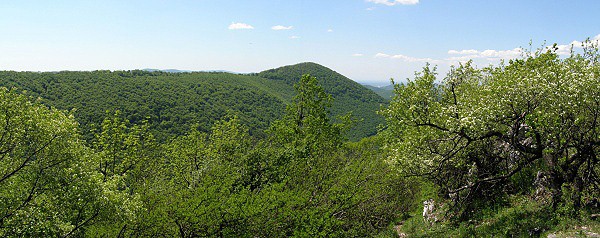
Sharp stone castle is located at 562 m on the sharp ridge of limestone rock, which slopes steeply to the west. The castle was built during 13. century and served to protect the Czech way. Was heavily damaged in 1704 during uprisings and since then deteriorates. Yet the ruins of the castle is worth a visit. The individual ridges nice open views of the surrounding peaks, especially the nearby Forehead (716 m) and Veterlín (724 m), in a deep wooded valley and neighboring mountains. For more information on the castle will be a separate article.
Peak Zaruba
From the castle goes red tourist mark for open limestone ridge with numerous rocks. Krajinova very beautiful stretch with nice views. In spring there are plenty of protected flowers blooming, which here found suitable growing conditions. Again, we are entering the forest and its cool shade. Shortly before we see even in the southwest silhouette Swimming Castle, Which stands on a steep limestone cliff. Climb abating, there are more rocks and after a while the peak Zaruba (767 m) with a wooden cross, and a guidepost box with top book, in which perpetuated.
In Malé Karpaty already above does not work, we are at their highest point. Perspectives are grown beeches limited, except for the southern direction. In the south we will see the top of the loaf with a known Great tower, sharp limestone peak Vápenná etc. expending effort was definitely worth it. The extraordinary value Zaruba is the fact that they are Zaruba National Nature Reserve, which was established in 1994.
The descent from the top Zaruba
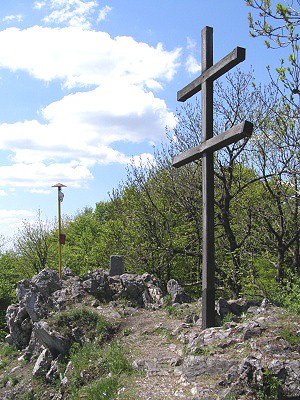
After a short rest descend to Zaruba crossroads (745 m), where we turn right and follow the green trail begin to descend the steep southern slope of the peak Zaruba. It surrounds us light beech forest with real forest giants. Although the oldest has failed to resist the effects of gravity and commanded the ground to make way for the next generation of forest.
Beginning to penetrate into the nose sharp odor of garlic. And indeed, in the undergrowth there are chunks of blossoming wild garlic. In such quantities as here in the Little Carpathians've never seen it. Dozens and dozens of hectares of forest literally blossomed and the smells of strong aromatic smell of garlic.
We get to saddle Zaruba (625 m), in which left turns blue and green TZ Smolenickému to lock and camp under Strawberry Cave Driny. We will continue right to the west of the blue TZ into a deep wooded valley between the peaks and Zaruba Veterlín. We are still accompanied by the heady aroma of garlic ...
Glimpse through the trees for a moment sharp stone castle that we watch in front of some the most visited and already we are getting on a paved path along which continue right up to the crossroads Birkenau (349 m)Where we use the tarmac road to us after a while (right) leads back to the starting point at Beech reservoir. The entire circuit takes us about 5 hours including stops and photography, the overall height is about 450 meters.
